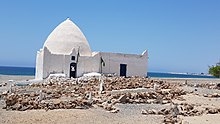Sheikh Ishaq الشيخ إسحاق | |
|---|---|
 Tomb of Sheikh Ishaaq in Maydh, Sanaag, Somaliland | |
| Personal life | |
| Died | 12th century Maydh, modern-day Somaliland |
| Children | Ahmed (Tolje'lo) Musa (Je'lo) Muhammad ('Ibran) Ibrahim (Sanbuur) Abd al-Rahman (Awal) Muhammad (Arap) Ayub Isma'il (Garhajis) |
| Region | Somaliland, Ethiopia, Djibouti |
| Main interest(s) | Islamic literature, Islamic philosophy |
| Other names | Ash-Shaykh Ishaaq |
| Religious life | |
| Religion | Islam |
| Jurisprudence | Shafi’i school |
Ishaaq bin Ahmad bin Muhammad , more commonly known as Sheikh Ishaaq or Sheikh Isaaq (Arabic: الشيخ إسحاق بن أحمد بن محمد, romanized: Ash-Shaykh Isḥāq bin Aḥmad bin Muḥammad, Somali: Sheikh Isxaaq) is a prominent figure in the oral traditions of the Somali Isaaq clan-family. According to these traditions, which were also preserved in several Arabic hagiologies,[1] he was an Islamic scholar of the Shafi’i school who crossed the sea from Arabia to the Horn of Africa. He is traditionally regarded as the Sayyid forefather of the Isaaq clan-family, whose territory in the Horn of Africa is wide and densely populated.[2][3][4][5]
According to tradition, Sheikh Ishaaq traveled from Arabia to Somaliland in the 10th or 11th century, where he married two women; one from the local Dir clan and the other from the neighbouring Harari people.[6][7][8] He sired eight sons who are the common ancestors of the Isaaq clan-family. He remained in Maydh until his death.[9] He is said to have settled in what is today the Erigavo District, and to have established his capital at Maydh.[10]
The stories surrounding Sheikh Ishaaq have played an important role in establishing and reinforcing the Arab and Muslim identity of the Isaaq clan.[11] Scholar Christopher Ehret considers the founders of Somali clans like the Isaaq and the Darod to have been historical figures, but he regards the accounts surrounding them as legends.[12] While Sada Mire regards the foundation of Somali clan lineages by Arab progenitors as part of "the Somali Islamic myth of origin",[13] she does relate the legendary accounts surrounding them to historical migrations from South Arabia to Somalia.[14]
- ^ Drozdík 2005. Some of these were published by Gori 2003.
- ^ Ethnic Groups (Map). Somalia Summary Map. Central Intelligence Agency. 2002. Retrieved 2012-07-30. Perry–Castañeda Library Map Collection – N.B. Various authorities indicate that the Isaaq is among the largest east African clans who adopted the somali language [1], [2].
- ^ "Somalia – The great Somali migrations". Encyclopedia Britannica. Retrieved 2021-03-24.
- ^ Berns-McGown, Rima (1999). Muslims in the Diaspora: The Somali Communities of London and Toronto. Toronto: University of Toronto Press. pp. 27–28. ISBN 9780802082817.
- ^ Lewis, Ioan M., A Modern History of the Somali, fourth edition (Oxford: James Currey, 2002), pp. 22–23.
- ^ Nelson, Harold D. (1982). Somalia, a Country Study. U.S. Government Printing Office. p. 330.
- ^ Cite error: The named reference
:5was invoked but never defined (see the help page). - ^ I.M. Lewis, A Modern History of the Somali, fourth edition (Oxford: James Currey, 2002), pp. 31 & 42
- ^ Adam, Hussein M. (1980). Somalia and the World: Proceedings of the International Symposium Held in Mogadishu on the Tenth Anniversary of the Somali Revolution, October 15–21, 1979. Halgan.
- ^ Lewis, Ioan (1960). "The Somali Conquest of the Horn of Africa". Journal of African History. 1 (2): 213–230. doi:10.1017/S0021853700001808. JSTOR 180241. S2CID 162301641. p. 219.
- ^ Cite error: The named reference
Lewis1994was invoked but never defined (see the help page). - ^ Cite error: The named reference
:6was invoked but never defined (see the help page). - ^ Cite error: The named reference
Mire2020-mythwas invoked but never defined (see the help page). - ^ Cite error: The named reference
Mire2020Migrationswas invoked but never defined (see the help page).
